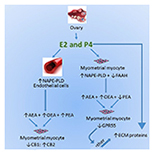
“Insulin resistance and β-cell dysfunction are the main defects in Type 2 Diabetes Mellitus (T2DM), and β-cell dysfunction and apoptosis is the critical determinant in the progression of T2DM. G-protein coupled receptor 55 (GPR55) is an orphan G-protein coupled receptor, which is activated by endocannabinoids and lipid transmitters. Recently, GPR55 was shown to regulate glucose and energy homeostasis, however its role in β-cell apoptosis was not studied. Therefore, in this study, we investigated the novel effect of GPR55 agonists, O-1602 and abnormal cannabidiol (Abn-CBD), on endoplasmic reticulum (ER) stress-induced apoptosis in mouse pancreatic β-cell lines, MIN6 and Beta-TC-6, and its underlying mechanisms. Our results showed that O-1602 and Abn-CBD reduced ER stress-induced apoptosis in MIN6 and Beta-TC-6 cells. This was through the phosphorylation of 3′-5′-cyclic adenosine monophosphate response element-binding protein (CREB) in β-cells, hence activating CREB downstream anti-apoptotic genes, Bcl-2 and Bcl-xL. Moreover, O-1602 and Abn-CBD directly activated kinases, CaMKIV, Erk1/2 and PKA, to induce CREB phosphorylation. Therefore, our results indicated that GPR55 agonists protected from β-cell apoptosis through CREB activation, thus up-regulating anti-apoptotic genes. In conclusion, our study provided a novel protective effect of GPR55 agonists on ER stress-induced apoptosis in β-cells and its underlying mechanisms mediating this protection, therefore we suggested that GPR55 might be a therapeutic target for T2DM.”
https://www.ncbi.nlm.nih.gov/pubmed/30841431
https://www.sciencedirect.com/science/article/pii/S0753332218375668?via%3Dihub




 “Bone is a complex tissue of the with unique properties such as high strength and regeneration capabilities while carrying out multiple functions. Bone regeneration occurs both in physiological situations (bone turnover) and pathological situations (e.g. fractures), being performed by osteoblasts and osteoclasts. If this process is inadequate, fracture nonunion or aseptic loosening of implants occurs and requires a complex treatment.
“Bone is a complex tissue of the with unique properties such as high strength and regeneration capabilities while carrying out multiple functions. Bone regeneration occurs both in physiological situations (bone turnover) and pathological situations (e.g. fractures), being performed by osteoblasts and osteoclasts. If this process is inadequate, fracture nonunion or aseptic loosening of implants occurs and requires a complex treatment.
 “Marijuana extracts (
“Marijuana extracts (

